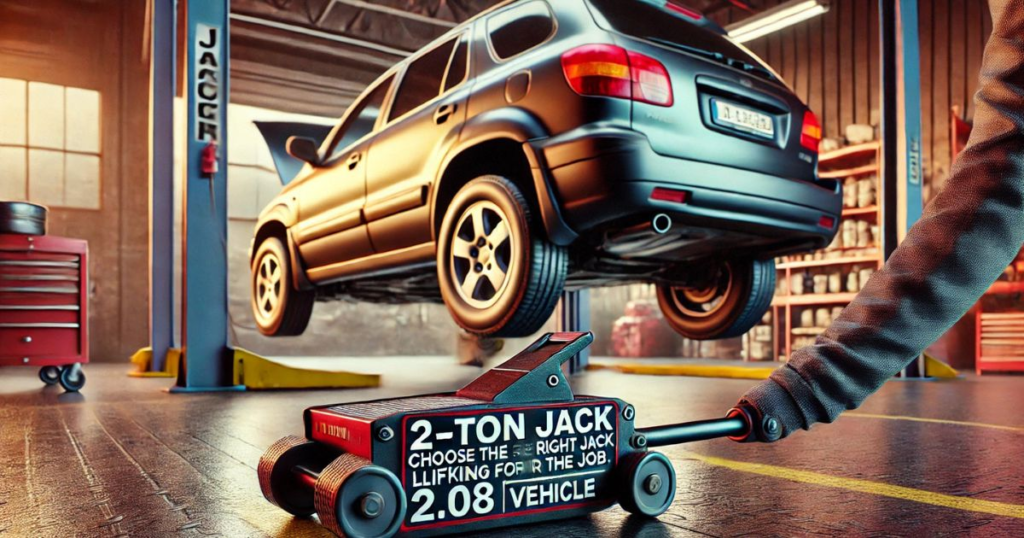
When it comes to lifting your car for maintenance or repairs, selecting the right jack is crucial for safety and efficiency. One common question people often ask is: “Can a 2-ton jack be used for a vehicle that weighs 2.08 tons?” This article will thoroughly examine this question by looking into factors like weight capacity, safety margins, and best practices for using jacks. We’ll break down the key considerations and guide you on how to make the safest choice.
What Does 2.08 Tons Mean?
When we refer to a vehicle weighing 2.08 tons (about 4160 lbs), we’re talking about its overall weight, which includes the body, engine, fluids, and any cargo inside. Knowing the weight of your car is the first step toward choosing the correct jack for the job. Having this precise weight allows you to pick a jack that will safely lift the vehicle without exceeding its rated capacity.
Understanding the 2-Ton Jack
A 2-ton jack is designed to lift up to 2 tons (or 4000 lbs) of weight. This weight capacity is adequate for many compact cars, sedans, and smaller vehicles. However, if you’re working on a car that weighs slightly more, like a 2.08-ton vehicle, can the 2-ton jack still do the job? Let’s dig deeper into this compatibility.
Analyzing the Compatibility

Weight Overload Factor
At first glance, a vehicle weighing 2.08 tons seems to be only 80 kg (around 176 lbs) over the capacity of a 2-ton jack. While that might seem like a small difference, it’s crucial not to operate a jack at or near its maximum capacity. When a jack is overloaded, even slightly, it can fail, leading to serious accidents.
Safety Margin Guidelines
To ensure safe operation, most experts recommend using a jack at no more than 75-80% of its rated capacity. For example, for a 2-ton jack, it would be wise to only lift vehicles weighing up to approximately 1.6 tons. Operating at a lower weight capacity ensures the jack’s longevity, improves safety, and reduces the chances of failure.
Safety Risks Involved
Using a jack that isn’t rated for the weight of your vehicle poses serious risks. Here are some of the dangers associated with lifting a vehicle that exceeds the jack’s capacity:
Jack Failure
When you push a jack beyond its limits, there’s a significant risk of failure. The jack may give way, causing the vehicle to fall suddenly, which can result in significant damage to the vehicle and potentially cause injury.
Injury Risks
A sudden collapse of the vehicle could lead to injuries, especially if you’re working underneath it. Even with proper precautions, a jack that is near its weight limit can be dangerous and unpredictable.
Vehicle Damage
Apart from safety risks, using a jack that’s too small for the job can also damage the vehicle itself. The car’s undercarriage or structural components may suffer from insufficient support, leading to costly repairs down the line.
Alternatives and Solutions

If you’re in a situation where your current jack is not rated for your vehicle’s weight, here are some alternatives to consider:
Upgrade Your Jack
If your vehicle exceeds the 2-ton weight limit, it’s advisable to upgrade to a more robust jack. A 2.5-ton or 3-ton jack would be a better choice for vehicles weighing slightly more than 2 tons. Upgrading ensures a more secure lifting operation and gives you peace of mind.
Using Jack Stands
Regardless of the jack’s weight capacity, always use jack stands when working under a lifted vehicle. Jack stands provide extra safety by supporting the vehicle even if the jack were to fail.
Consulting a Professional
If you’re unsure about the suitability of your jack, consider consulting a professional mechanic. They can provide guidance on the right tools for the job and ensure your safety during the maintenance process.
How to Choose the Right Jack
Choosing the right jack involves more than just checking the weight capacity. Here’s how you can ensure you’re making the best choice for your vehicle:
Assess Your Vehicle’s Weight
First, check the manufacturer’s specifications for the vehicle’s weight. This can usually be found in the owner’s manual or on a sticker located inside the driver’s side door. Knowing your car’s exact weight will guide you in selecting a jack with an appropriate weight capacity.
Consider Weight Distribution
It’s not just about the total weight of the vehicle, but also how that weight is distributed. If your vehicle is heavily loaded or unbalanced, the jack needs to handle the load distribution properly. This means paying attention to the placement of the jack under the vehicle to ensure stability.
Lifting Height Considerations
Different jacks have varying lifting heights, so make sure the jack you choose can raise your vehicle to the required height for your repair. Whether you need a low-profile jack or one with a higher lifting range, this is an important consideration when selecting the right equipment.
Conclusion: Safety First
So, can you safely use a 2-ton jack for a vehicle weighing 2.08 tons? Technically, it is possible, but it’s not recommended due to the risks involved. To ensure safety and avoid potential damage or injury, always choose a jack that exceeds the weight of your vehicle. If necessary, invest in a more powerful jack, use jack stands for added safety, and never underestimate the importance of professional advice.
In summary, when lifting your vehicle, prioritize safety by using the correct equipment for the job. Always follow manufacturer recommendations, consider safety margins, and choose the right tools for your specific needs. By doing so, you’ll create a safer, more reliable working environment, allowing you to perform maintenance tasks with confidence.